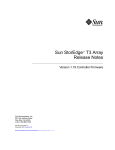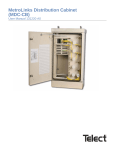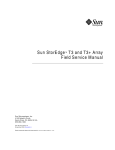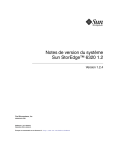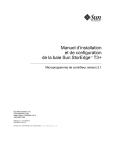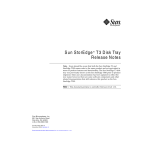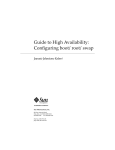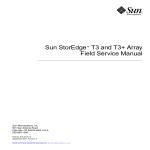Download Sun StorEdge™ T3+ Array Releases Notes
Transcript
Sun StorEdge™ T3+ Array Releases Notes Version 2.0 Controller Firmware Sun Microsystems, Inc. 901 San Antonio Road Palo Alto, CA 94303 U.S.A. 650-960-1300 Part No. 816-1983-10 August 2001, Revision A Send comments about this document to: [email protected] Copyright 2001 Sun Microsystems, Inc., 901 San Antonio Road, Palo Alto, CA 94303-4900 U.S.A. All rights reserved. This product or document is distributed under licenses restricting its use, copying, distribution, and decompilation. No part of this product or document may be reproduced in any form by any means without prior written authorization of Sun and its licensors, if any. Third-party software, including font technology, is copyrighted and licensed from Sun suppliers. Parts of the product may be derived from Berkeley BSD systems, licensed from the University of California. UNIX is a registered trademark in the U.S. and other countries, exclusively licensed through X/Open Company, Ltd. Sun, Sun Microsystems, the Sun logo, AnswerBook2, docs.sun.com, Sun StorEdge, SunSolve, and Solaris are trademarks, registered trademarks, or service marks of Sun Microsystems, Inc. in the U.S. and other countries. All SPARC trademarks are used under license and are trademarks or registered trademarks of SPARC International, Inc. in the U.S. and other countries. Products bearing SPARC trademarks are based upon an architecture developed by Sun Microsystems, Inc. The OPEN LOOK and Sun™ Graphical User Interface was developed by Sun Microsystems, Inc. for its users and licensees. Sun acknowledges the pioneering efforts of Xerox in researching and developing the concept of visual or graphical user interfaces for the computer industry. Sun holds a non-exclusive license from Xerox to the Xerox Graphical User Interface, which license also covers Sun’s licensees who implement OPEN LOOK GUIs and otherwise comply with Sun’s written license agreements. Federal Acquisitions: Commercial Software—Government Users Subject to Standard License Terms and Conditions. DOCUMENTATION IS PROVIDED “AS IS” AND ALL EXPRESS OR IMPLIED CONDITIONS, REPRESENTATIONS AND WARRANTIES, INCLUDING ANY IMPLIED WARRANTY OF MERCHANTABILITY, FITNESS FOR A PARTICULAR PURPOSE OR NON-INFRINGEMENT, ARE DISCLAIMED, EXCEPT TO THE EXTENT THAT SUCH DISCLAIMERS ARE HELD TO BE LEGALLY INVALID. Copyright 2001 Sun Microsystems, Inc., 901 San Antonio Road, Palo Alto, CA 94303-4900 Etats-Unis. Tous droits réservés. Ce produit ou document est distribué avec des licences qui en restreignent l’utilisation, la copie, la distribution, et la décompilation. Aucune partie de ce produit ou document ne peut être reproduite sous aucune forme, par quelque moyen que ce soit, sans l’autorisation préalable et écrite de Sun et de ses bailleurs de licence, s’il y en a. Le logiciel détenu par des tiers, et qui comprend la technologie relative aux polices de caractères, est protégé par un copyright et licencié par des fournisseurs de Sun. Des parties de ce produit pourront être dérivées des systèmes Berkeley BSD licenciés par l’Université de Californie. UNIX est une marque déposée aux Etats-Unis et dans d’autres pays et licenciée exclusivement par X/Open Company, Ltd. Sun, Sun Microsystems, le logo Sun, AnswerBook2, docs.sun.com, Sun StorEdge, SunSolve, et Solaris sont des marques de fabrique ou des marques déposées, ou marques de service, de Sun Microsystems, Inc. aux Etats-Unis et dans d’autres pays. Toutes les marques SPARC sont utilisées sous licence et sont des marques de fabrique ou des marques déposées de SPARC International, Inc. aux Etats-Unis et dans d’autres pays. Les produits portant les marques SPARC sont basés sur une architecture développée par Sun Microsystems, Inc. L’interface d’utilisation graphique OPEN LOOK et Sun™ a été développée par Sun Microsystems, Inc. pour ses utilisateurs et licenciés. Sun reconnaît les efforts de pionniers de Xerox pour la recherche et le développement du concept des interfaces d’utilisation visuelle ou graphique pour l’industrie de l’informatique. Sun détient une licence non exclusive de Xerox sur l’interface d’utilisation graphique Xerox, cette licence couvrant également les licenciés de Sun qui mettent en place l’interface d’utilisation graphique OPEN LOOK et qui en outre se conforment aux licences écrites de Sun. LA DOCUMENTATION EST FOURNIE “EN L’ETAT” ET TOUTES AUTRES CONDITIONS, DECLARATIONS ET GARANTIES EXPRESSES OU TACITES SONT FORMELLEMENT EXCLUES, DANS LA MESURE AUTORISEE PAR LA LOI APPLICABLE, Y COMPRIS NOTAMMENT TOUTE GARANTIE IMPLICITE RELATIVE A LA QUALITE MARCHANDE, A L’APTITUDE A UNE UTILISATION PARTICULIERE OU A L’ABSENCE DE CONTREFAÇON. Please Recycle Sun StorEdge T3 Array Release Notes Introduction This document contains late-breaking product information and known issues that are specific to the Sun StorEdge™ T3+ array. Issues documented previously for the Sun StorEdge T3 array model that do not appear in these release notes have either been resolved or do not apply to the Sun StorEdge T3+ array. Review this document so that you are aware of issues or requirements that can impact the installation and operation of the array. The information in this document supplements the information contained in the Sun StorEdge T3 and T3+ Array Installation, Operation, and Service Manual and the Sun StorEdge T3 and T3+ Array Administrator’s Guide. Use this release note in conjunction with other release notes and README files that you may have received with other software products related to the Sun StorEdge T3+ array, such as Sun StorEdge Component Manager software and VERITAS Volume Manager. These release notes are organized as follows: ■ “Required Patches” on page 2 ■ “Diagnostics Issue” on page 3 ■ “Sun Cluster Issues” on page 4 ■ “VERITAS Issues” on page 4 ■ “Service Issues” on page 6 ■ “System Level Issues” on page 8 ■ “EPROM Issues” on page 11 1 Required Patches Install all the required patches listed below before installing the Sun StorEdge T3+ array. These patches are available on the SunSolve™ web site: http://sunsolve.sun.com To retrieve patches: 1. In the SunSolve Online column, click on Patches. 2. In the Patches column, click on PatchPro. 3. Click on Storage Products. Refer to the patch README file for instructions and patch information. Note – You may need other patches not listed below for related software products such as Sun StorEdge Component Manager or VERITAS Volume Manager. Refer to the SunSolve web site and to the release notes of these products for their required patches. TABLE 1 System Type All Required Patches SolarisTM 2.6 Operating Environment Solaris 7 Operating Environment Solaris 8 Operating Environment 105356-18 or later (ssd driver) 107458-13 or later (ssd driver) 109524-05 or later (ssd driver) 106226-01 or later (format patch) 107473-07 or later (luxadm patch) 105181-26 or later (kernel update patch) 107834-03 or later (DKIO Extensions Patch) 106541-16 or later (Kernel Update Patch) VERITAS 3.0.4 110261-04 110262-03 110263-03 VERITAS 3.1 110253-04 110254-04 110255-04 VERITAS 3.1.1 110451-02 110452-02 111118-02 2 Sun StorEdge T3+ Array Release Notes • August 2001 TABLE 1 System Type PCI (ifp) Only SBus/sf-socal Only Required Patches (Continued) SolarisTM 2.6 Operating Environment Solaris 7 Operating Environment Solaris 8 Operating Environment 107280-08 or later (ifp/PCI driver/PCI Systems only) 107292-07 or later (ifp/PCI driver/PCI Systems only) 109189-02 or later (ifp/PCI driver/PCI Systems only) 109399-03 or later (PCI Host Adapter Firmware Fcode) 109399-03 or later (PCI Host Adapter Firmware Fcode) 109399-03 or later (PCI Host Adapter Firmware Fcode) 105375-26 or later (sf/socal driver/SBus systems only) 107469-08 or later (sf/socal driver/SBus systems only) 109460-05 or later (sf/socal driver/SBus systems only) 109400-03 or later (SBus Host Adapter Firmware Fcode) 109400-03 or later (SBus Host Adapter Firmware Fcode) 109400-03 or later (SBus Host Adapter Firmware Fcode) 111095-04 111097-04 111412-04 111413-04 Sun StorEdge Network Foundation Software on PCI Network Adapters1 1. Applies only to the following PCI network adapters: Sun StorEdge PCI Single Fibre Channel network adapter, Sun StorEdge PCI Dual Fibre Channel network adapter, and Sun StorEdge CompactPCI Dual Fibre Channel network adapter. Diagnostics Issue ! Caution – Sun StorEdge T3+ array ofdg utility is for service use only. Use of this feature will make data unavailable. The array firmware provides a command-line and graphical user interface to a diagnostics tab provided by Sun StorEdge Component Manager 2.2. The ofdg utility is used to perform offline diagnostic testing. This tool should be used only by qualified Sun service providers at this time. The ofdg utility is limited in its test capabilities and must be run while the system is offline to avoid problems. Sun StorEdge T3 Array Release Notes 3 Sun Cluster Issues Note – The Sun StorEdge T3+ array does not support Sun™ Cluster 2.2 software. 4406863: Sun Cluster cannot use recon_rate=high array setting. If the Sun StorEdge T3+ array is configured in a Sun Cluster environment, use either the low or med setting for the recon_rate. You can change this setting using the array sys recon_rate command. The recon_rate=high setting on an array can cause node takeover issues. VERITAS Issues 4264118: DMP failback is not automatically enabled (VERITAS Volume Manager 3.0.4 only). After installing the VERITAS software, to ensure correct operation of VERITAS Dynamic Multipathing (DMP) auto failback operations, type the following command (as root) on host systems connected to Sun StorEdge T3+ arrays: # vxdmpadm start restore interval=60 policy=check_all Note – You must run this command after every system reboot. 4 Sun StorEdge T3+ Array Release Notes • August 2001 4282806: vxinstall only displays the first array controller for the configuration. During the vxinstall procedure, only the first connected host bus adapter in an array partner group is displayed. This occurs because vxinstall displays only the first path to an array partner group, even though other paths to the partner group have also been detected. This can be misleading since in array configurations, volumes can also exist through second controller data paths. You do not need to take any special action to correct this. Allow vxinstall to proceed to completion. Once the host system has rebooted from the VERITAS installation, all paths to the array are properly recognized by the Volume Manager software. 4313336: Enable DMP support for a Sun StorEdge T3+ array and StorEdge A3500 configuration. DMP support is necessary to obtain full redundancy between interconnected array controller units. If you are connecting redundant Sun StorEdge T3+ arrays to a host running DMP that also has StorEdge A3500 storage devices connected to it, you must remove the Alternate Pathing (AP) file to make sure that both types of storage devices co-exist properly. To perform the following procedure, you must be logged in as root. 1. On the data host, type: # ls -l /kernel/drv/ap 2. If the /kernel/drv/ap file is of 0 length, remove /kernel/drv/ap by typing: # rm /kernel/drv/ap Sun StorEdge T3 Array Release Notes 5 3. Reboot the system. # reboot If the /kernel/drv/ap file is not of 0 length, AP is installed and you cannot enable DMP because AP and DMP cannot co-exist. Sun Microsystems, Inc. recommends that you remove the AP product entirely using pkgrm (1m). Refer to the AP product documentation for further details. 4253044: Volume usage does not refresh. Within the Volume Manager Storage Administrator (VMSA) product, volume usage information might not be refreshed correctly. If this problem is encountered, restart the VMSA application to update the volume usage statistics. Service Issues FRU removal for longer than 30 minutes will initiate a partner group shutdown. If any field replaceable unit (FRU) is removed for an extended period of time, thermal complications might result. To prevent this, the Sun StorEdge T3+ array is designed so that an orderly shutdown occurs when a component is removed for longer than 30 minutes. Therefore, a replacement part must be immediately available before starting a FRU replacement procedure. You must replace a FRU that has been removed within 30 minutes or the array, and all attached arrays in that partner group, will shut down and power off. 6 Sun StorEdge T3+ Array Release Notes • August 2001 4374724: Multiple non-adjacent disk failures in a RAID 1 stripe. In the event of multiple non-adjacent drive failures in a RAID 1 volume on a Sun StorEdge T3+ array, the volume can be unmounted. Single drive failures within the RAID 1 volume are handled correctly and, in those cases, the RAID 1 volume remains mounted and accessible from the host. 4348664: fru list command should display new drive firmware versions automatically. After upgrading the Sun StorEdge T3+ array internal drive firmware, perform a disk version und1-9 operation on the upgraded drives. This array command ensures that correct drive firmware version information gets updated correctly in internal databases. If you do not do this after a drive firmware upgrade, it is possible that stale drive firmware version information can be displayed when using the fru list command. For more information on using the disk version and fru list commands, refer to the Sun StorEdge T3 and T3+ Array Administrator’s Guide. 4415132: Cache mode auto setting does not behave as documented for workgroup configurations. In workgroup configurations (not fully redundant), the auto cache mode setting currently enables write-behind caching of data. The normal behavior for the auto cache mode in a workgroup configuration is to enable write-through caching. Writethrough caching protects data in case of an array failure in nonredundant configurations. In the write-behind cache mode, data loss could occur if there is an array failure because cache is not mirrored. To protect data in a workgroup configuration, set the cache mode to writethrough using the sys cache writethrough command on the array. If you continue to use write-behind caching, use a host-based mirroring solution to protect data. For more information on changing the cache setting, refer to Sun StorEdge T3 and T3+ Array Administrator’s Guide. Sun StorEdge T3 Array Release Notes 7 System Level Issues Bootability The Sun StorEdge T3+ array supports warm bootability for hosts running the Solaris operating environment that are connected by a SOC+ host bus adapter (HBA). Warm bootability means that the Sun StorEdge T3+ array must be completely booted before attempting to boot the host from the array volume. Warm bootability is supported by Solaris 7 (Release 11/99) and later. Bootability for the Solaris 2.6 environment is not currently supported. Cold bootability—that is, booting the Sun StorEdge T3+ array and host at the same time—is not supported. Note – Only SOC+ HBAs used in the Solaris 7 operating environment, and later releases of the Solaris operating environment, support warm bootability at this time. Warm bootability is not supported with the ifp (Qlogic 2100) HBA. Note – See issue 4253419 that follows. The delayed time required for a Sun StorEdge T3+ array to become fully available to host I/O operations may cause issues, especially if the array is used as a boot device. If you have encountered this situation, contact an authorized Sun Service Provider or Sun Service at 1-800-USA4SUN for an evaluation. 4253419: Sun StorEdge T3+ array controller extended boot times. In some cases, host systems running the Solaris software environment can boot faster than Sun StorEdge T3+ arrays. This results in a host configuration that might not be able to detect all available array storage during a full AC power-loss boot cycle. This can occur when the host system has minimal amounts of memory (or memory power-on self-test operations have been disabled). When powering up a configuration, always power on Sun StorEdge T3+ arrays before the host server. 8 Sun StorEdge T3+ Array Release Notes • August 2001 If this scenario still occurs, contact an authorized Sun Service provider or Sun Service at 1-800-USA-4SUN for an evaluation and suggested workaround. Note – Any modification to the system nonvolatile random access memory (NVRAM) configuration should be avoided as errors can result in extensive system down time. Before making modifications to NVRAM, contact Sun Service. 4427400: bootdelay parameter set to 60 seconds can cause an array partner group boot issue. The default bootdelay parameter for the Sun StorEdge T3+ array is set to a value of 3. To avoid problems with booting the array system, do not reset the bootdelay parameter to a higher value than the default setting. 4309324: Extend RARP time-out to better support Ethernet switches. In a first-time installation, the Sun StorEdge T3+ array is assigned its IP address from a RARP server that has been configured with the address.When first powered on, the array waits for the RARP server response. If the array and RARP server are connected to a Cisco Catalyst switch, the switch takes longer to activate the interface than the array, and the array will time out waiting for the RARP server response. To avoid this problem, change the spanning tree setting of the Cisco Catalyst port to “portfast,” which allows the switch to first enable the port and then check for integrity using the spanning tree algorithm. By default, the switch checks the integrity of the spanning tree first and then enables the port. To change the port settings, refer to the switch documentation for instructions. 4395542: SUNWlux package installation required for hosts running Solaris 2.6 environment. The SOC patch (105375) for the Solaris 2.6 software environment will install and not fail, even when SUNWlux packages are not installed on the host. This results in a configuration where the host can see only one LUN on a Sun StorEdge T3+ array. If this occurs and there is no indication of other problems, check that SUNWlux packages are installed correctly on the host. Sun StorEdge T3 Array Release Notes 9 4362567: Use default port addressing on array. The default setting for Sun StorEdge T3+ array port addressing is hard. Although it is possible to change this setting, use the default setting to avoid unexpected system behavior. 4426672: Power management on host is not supported. If a Sun StorEdge T3+ array is connected to a host bus adapter (HBA) with power management enabled, it can cause failover issues. To avoid this, disable power management on HBAs. 4292162: Permanent serial cable connections to the array are not recommended. ! Caution – The serial port cable must be disconnected from the array to meet regulatory emissions requirements. Do not leave it connected after performing a procedure. Note – The serial cable is used for special service procedures only and should not be used by anyone except authorized, qualified service personnel. The serial cable must be removed when the service procedure has been completed. Because the Sun StorEdge T3+ array serial port provides diagnostic and EPROM access to the system during the boot cycle, there is a risk of a security breach if the serial cable is left connected to the array. To avoid this risk, remove the serial cable connection from the array to external host systems after use. 10 Sun StorEdge T3+ Array Release Notes • August 2001 EPROM Issues Note – Changes to settings at the erasable programmable read-only memory (EPROM) level can be done only through a serial cable connection with the array. Use of the serial cable is reserved for special field service procedures only. 4293509: System bootmode setting at the EPROM level can be overwritten at the application level. If changes are made to array settings at the EPROM level, they may not be persistent after the partner group has booted. This is important specifically when changing the bootmode. For example, if the array has been set to the tftpboot mode at the application level and later is set back to the default autoboot mode at the EPROM level, the autoboot setting will be overwritten with the tftpboot setting. As a result, you will not be able to boot without a tftpboot server. To avoid this, check the array settings at the application level before rebooting and make sure the bootmode is set to autoboot. 4300136: An array in a partner group configuration that sits idle at the EPROM level for more than five minutes can be disabled by its partnered controller. One controller in a partner group can disable the other controller being held at the EPROM level. This happens when using the serial cable interface to a controller in a partner group if the boot process is interrupted leaving the system at the EPROM level for more than five minutes. If this happens, the disabled controller will continuously output St to the console. To recover access to that controller, telnet into the partner group and use the sys stat command to determine which controller needs to be enabled. Re-enable the disabled controller with the enable u? command. The controller that was previously held at the EPROM level resets and boots as the alternate. Sun StorEdge T3 Array Release Notes 11 12 Sun StorEdge T3+ Array Release Notes • August 2001














